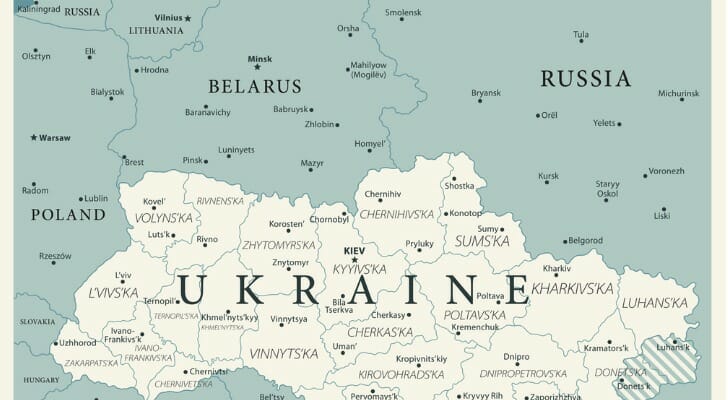 The conflict in Ukraine is evolving rapidly. While the focus is understandably on the loss of life and the geopolitical consequences of the conflict, there is also a significant impact on the global financial system that can’t be ignored. Global stocks and bonds plummeted last week following Russia’s “special military operation” announcement, and several Western countries have hit back with economic sanctions. All of this has lead to heightened uncertainty around the globe.
The conflict in Ukraine is evolving rapidly. While the focus is understandably on the loss of life and the geopolitical consequences of the conflict, there is also a significant impact on the global financial system that can’t be ignored. Global stocks and bonds plummeted last week following Russia’s “special military operation” announcement, and several Western countries have hit back with economic sanctions. All of this has lead to heightened uncertainty around the globe.
Given the fluidity of the situation, it is difficult to predict how the market will react. Goldman Sachs predicted that the S&P 500 Index could fall a dramatic 6% if Russia escalates the conflict to full-out war, suggesting that the geopolitical risk may not be fully accounted for by investors. At the same, Russia currently supplies between 25% and 30% of European energy supplies, and many experts believe that Russian President Vladimir Putin has a strong interest in maintaining that economic sales channel.
As a result, the likelihood remains high that the Russia-Ukraine crisis will continue as a source of volatility for an extended period. Turbulent times can make for a doubtful investing atmosphere, and investment giant UBS recommends that investors follow these five steps to protect themselves from further market uncertainty.
Need advice during times of financial volatility? Consider working with a trusted financial advisor who can help manage your portfolio and create a comprehensive financial plan for you and your family.
Keep a Diversified Portfolio
Historically the greatest risk for investors from geopolitical crises has come from overreacting and under-diversifying, UBS says. Although it is impossible to judge the timing and magnitude of the effects of such events, generally these conflicts have not prevented equities from moving higher over the medium term. In other words, don’t be spooked by the volatility.
By diversifying across regions, sectors and asset classes, investors can reduce their exposure to risks related to the Russia-Ukraine crisis. For example, the S&P 500’s combined revenue exposure to Russia and Ukraine is only about 1%, and some companies and funds have already announced decisions to divest their stakes in Russian-held assets.
Diversification offers strong bear market protection as well. In the past, the S&P 500 fell an average 34.5% during bear markets and took at most three-and-a-half years to recover. The 60/40 portfolio also lost an average of 20% in value but rebounded to record highs within two-and-a-half years.
Hedge Using Commodities
 Russia supplies nearly a third of Europe’s energy, and Ukraine exports large quantities of corn, wheat and oilseed. The risk of supply disruptions is high, and UBS suggests that commodities can serve as an effective geopolitical hedge for investment portfolios. Not only would commodities offer relatively high returns in the face of persistent inflation and higher interest rates, but a potential supply squeeze would also drive up value rapidly, offsetting a concurrent decline in equities.
Russia supplies nearly a third of Europe’s energy, and Ukraine exports large quantities of corn, wheat and oilseed. The risk of supply disruptions is high, and UBS suggests that commodities can serve as an effective geopolitical hedge for investment portfolios. Not only would commodities offer relatively high returns in the face of persistent inflation and higher interest rates, but a potential supply squeeze would also drive up value rapidly, offsetting a concurrent decline in equities.
Position for a Strong U.S. Dollar
The U.S. dollar is a global “safe-haven” currency that has historically rallied in times of geopolitical uncertainty. Additionally, the Federal Reserve has indicated that it will raise interest rates in the upcoming months, which will likely support the currency’s strength.
As such, UBS sees the U.S. dollar as an attractive currency position. You can benefit from this by buying into domestic company shares, as well as U.S.-dollar and hedged-currency exchange-traded funds. The investment firm notes, however, that a strong dollar will likely negatively impact the value of silver and gold.
Buy Global Growth Winners
In spite of concerns surrounding the Russia-Ukraine conflict, inflation and interest rates, it is important to recognize that economic growth is still accelerating globally. As COVID-related restrictions are lifted, growth is roaring back with a vengeance.
UBS believes that conditions continue to favor value and cyclical sectors and markets, such as energy, financials and the Eurozone. Even given the events in Eastern Europe, Eurozone equities have outperformed U.S. equities over the past month and the force of their economic recovery may potentially continue to drive global markets in the near future.
Build Up Defensive Positions
Even so, volatility remains very high, and it seems prudent to balance cyclical exposure with defensive strategies. UBS prefers balancing riskier exposure with global healthcare stocks, in addition to employing dividend strategies and dynamic allocation to improve overall risk-return profiles.
Employing a defensive dividend strategy can mean shifting some assets to stocks that provide a consistent dividend and stable earnings regardless of the state of the overall stock market or economy. Dynamic allocation, on the other hand, is a portfolio management strategy that frequently adjusts your asset allocation classes to suit market conditions. Both strategies can build up defensive positions to create a more robust portfolio.
Bottom Line
 The Russia-Ukraine crisis is unlikely to be resolved in the short term, but investors should not let their fears get in the way. Investors with longer time horizons should aim to position themselves more defensively to ride out the market’s volatility, as historical data suggests the market will recover in the medium term.
The Russia-Ukraine crisis is unlikely to be resolved in the short term, but investors should not let their fears get in the way. Investors with longer time horizons should aim to position themselves more defensively to ride out the market’s volatility, as historical data suggests the market will recover in the medium term.
Tips for Investing During Volatile Times
- Investing can be emotional, especially during volatile and difficult times. A professional can help manage your portfolio and create a solid, long-term financial plan, taking the emotion out of investing. So consider speaking with a qualified financial advisor. SmartAsset’s free tool matches you with up to three financial advisors who serve your area, and you can interview your advisor matches at no cost to decide which one is right for you. If you’re ready to find an advisor who can help you achieve your financial goals, get started now.
- Use SmartAsset’s free asset allocation calculator to get an estimate of the right mix of stocks, bonds and cash for your risk tolerance and investment goals.
Photo credit: ©iStock.com/pop_jop, ©iStock.com/JJ Gouin, ©iStock.com/miniseries